Growing Knowledge: U of A Researchers Share Findings at 2024 Agrivoltaics World Conference
Increased participation in conference activities shows how U of A's star is rising in this burgeoning field of research.
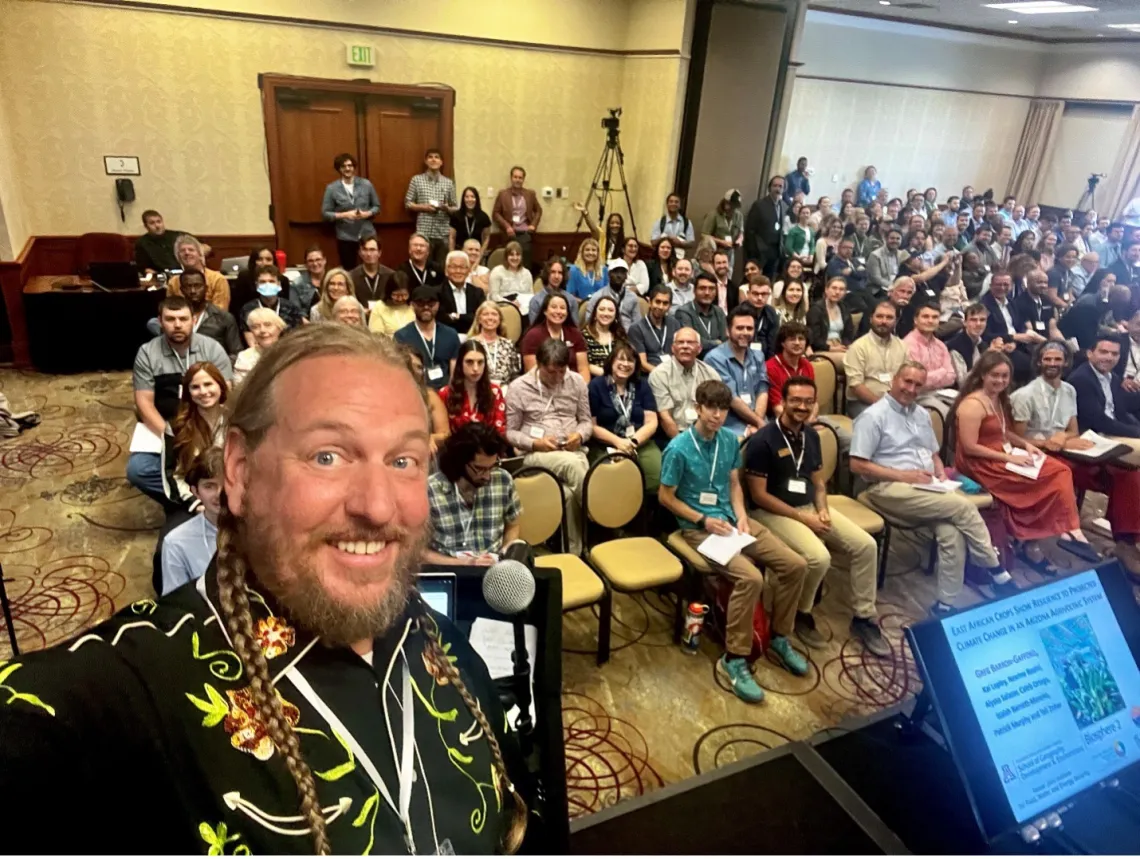
Dr. Greg Barron-Gafford speaks to a sold-out conference crowd about the physiological benefits of growing crops in agrivoltaic systems.
Greg Barron-Gafford, 2020-21 Udall Center Fellow and Professor in the School of Geography, Development, and Environment (SGDE), and Udall Center Director Andrea Gerlak traveled with two postdocs, four graduate students and research staff from the University of Arizona (UArizona) agrivoltaics interdisciplinary research team to participate in the Agrivoltaics World Conference (AWC) in Denver, Colorado.
As a result of his leadership in agrivoltaics research, Barron-Gafford was invited to co-chair the conference alongside Jordan Macknick of the National Renewable Energy Laboratory (NREL).
2024 marks the first time that the AWC was held in the United States, and the first time that UArizona participated in organizing the conference. The UArizona agrivoltaics research team traveled to Italy and South Korea in past years to participate in conference activities.
Featuring a variety of topics, from environmental modeling and crop physiology to questions of governance and policy, the AWC brings together scholars, industry professionals and policymakers from around the world to discuss the latest developments in agrivoltaics – a novel land use practice that allows for the co-production of agricultural products and solar energy on the same plot of land.
Crops Benefit from Solar Shade
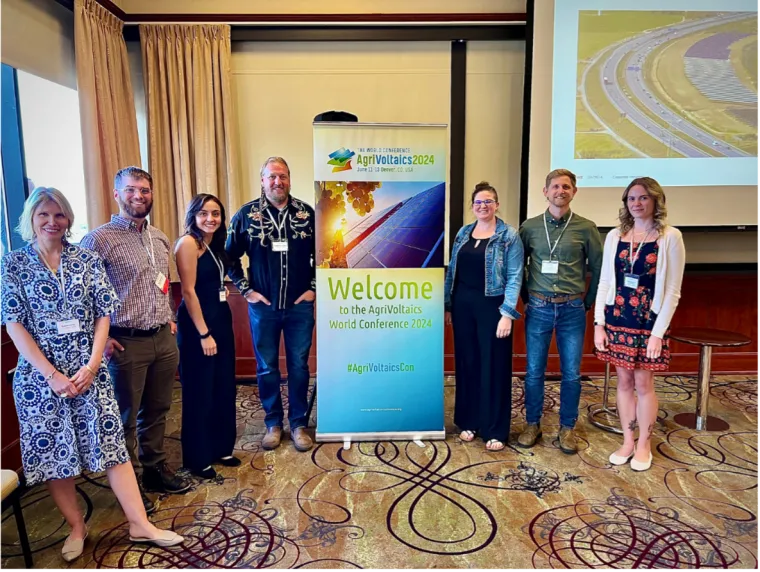
The UArizona team at the Agrivoltaics World Conference (from left): Andrea Gerlak, Tyler Swanson, Alyssa Salazar, Greg Barron-Gafford, Holly Andrews, Kai Lepley and Talitha Neesham-McTiernan. Not pictured: Carrie Seay-Fleming.
Barron-Gafford presented in a session highlighting the physiological benefits to crops grown in agrivoltaics systems.
In the study presented, the team grew crops that are commonly grown in East Africa to test how agrivoltaics might allow for increased resilience to projected climate change stressors. Crops grown in the agrivoltaic system were less water stressed and produced higher yields when compared to these same crops grown in full sun.
Barron-Gafford’s presentation highlighted how agrivoltaic systems have the potential to alleviate the negative impacts of climate change on agriculture in East Africa – where food insecurity and climate change stressors are already a serious concern.
The Social Side of the Agrivoltaics Equation
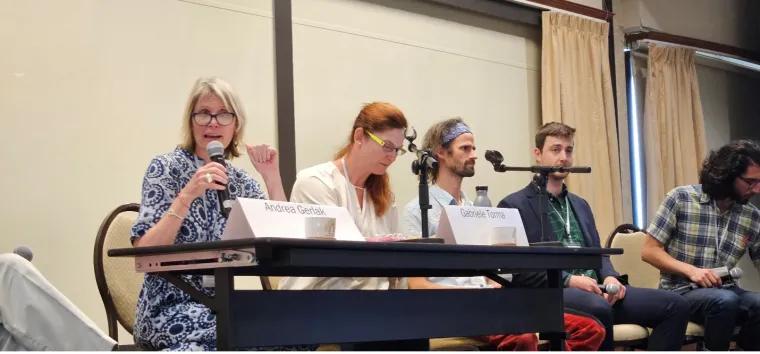
Udall Center Director Dr. Andrea Gerlak hosts a roundtable on the social aspects and diffusion of agrivoltaics.
In collaboration with Gabriele Torma from Aarhus University in Denmark, Gerlak moderated a roundtable with experts on the social aspects and diffusion of agrivoltaics. Roundtable participants represented several different countries including Taiwan, Germany, Austria, and the United States.
Gerlak and Torma provided opening and closing remarks and moderated a rich discussion on the challenges and barriers of scaling-up agrivoltaics while also addressing questions of equity and justice.
Two UArizona researchers associated with SGDE – postdoctoral researcher Carrie Seay-Fleming and graduate student Tyler Swanson – presented social science research from interviews with farmers and local government officials in Pinal County, Arizona.
Seay-Fleming emphasized the importance of place-based research on agrivoltaics and the unique role of water scarcity and water policy in shaping the possibilities for agrivoltaics in Pinal County. Swanson’s research demonstrated important differences between farmers’ perspectives and local government perspectives on solar development and agrivoltaics.
More Rising Stars in UArizona Agrivoltaics Research

Postdoctoral researcher Carrie Seay-Fleming (Left) and graduate student Tyler Swanson (Right) present social science research findings from interviews with farmers and local government officials in Pinal County, Arizona.
SGDE PhD student Nesrine Rouini and Alyssa Salazar, a member of Dr. Barron-Gafford’s research staff, presented their exciting work at the conference poster session.
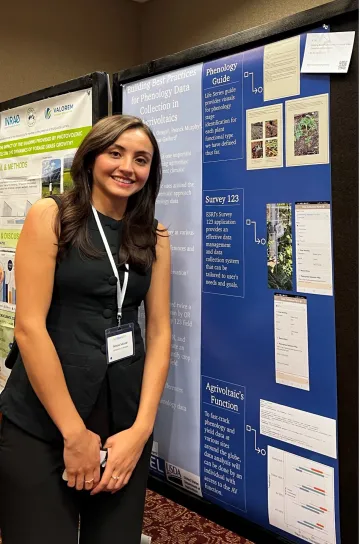
Alyssa Salazar presents her poster “Building Best Practices for Phenology Data Collection in Agrivoltaics” during the Agrivoltaics World Conference poster session.
Rouini shared results of her experiments growing lettuce in an agrivoltaic system, while Salazar showcased a survey tool for easily reporting and tracking plant phenology in agrivoltaic systems.
On the final day of the conference, postdoctoral researcher Holly Andrews chaired a session on agrivoltaics best practices while SGDE PhD student and NREL researcher Kai Lepley served as chair for an environmental modeling session.
As a part of this same session, SGDE PhD student Talitha Neesham-McTiernan presented research about the potential for agrivoltaics to reduce heat-related illness and stress among farmworkers. Neesham-McTiernan and her co-authors found that agrivoltaics can significantly improve human thermal comfort and that differences (between agrivoltaics and a control environment) are likely to be even greater in hot climates in agricultural regions like California and Arizona.
UArizona’s Agrivoltaic Impact
UArizona’s robust representation and participation throughout the conference, including sessions in the physical and social sciences, demonstrates the University’s leadership in this area of research.
The research team, led by Barron-Gafford, has received funding from both the US Department of Energy and the US Department of Agriculture to fund its research efforts.
In addition to presenting and facilitating during the conference, team members helped to plan and coordinate events including a visit to Jack’s Solar Garden, an on-farm community solar array that partners with UArizona, Colorado State University and the NREL for agrivoltaics research.
The 2024 AWC sold out, attracting over 500 participants from more than 30 countries representing a broad range of governments and industries.
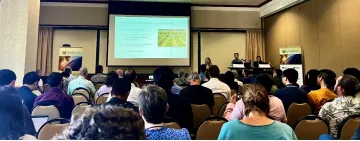
Talitha Neesham-McTiernan, PhD student in the School of Geography, Development and Environment, presents her research on the potential for agrivoltaic systems to reduce heat-related illness and stress among farm workers during a session on environmental modeling hosted by fellow PhD student Kai Lepley
The enthusiasm around the conference represents an increasing interest in dual-use solar and the belief that agrivoltaics can be an important lever to help build food-energy-water resilience. The UArizona research team looks forward to engaging in next year’s conference, set to be held on July 1-3, 2025 in Freiberg, Germany.
